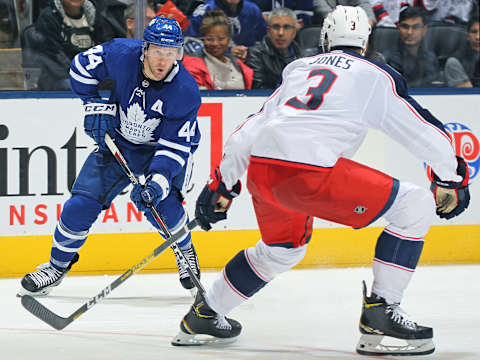Toronto Maple Leafs vs Blue Jackets: Special Teams Analysis


Special teams always play a major role in the outcome of a series, and the Toronto Maple Leafs should know this better than anyone.
Last year in the playoffs, the Boston Bruins scored on the powerplay on 7 out of 16 opportunities. As a contrast, the Toronto Maple Leafs powerplay only went 3 for 16.
The difference in special teams ultimately was the difference between winning the series or losing it.
The Blue Jackets had their own form of special team success against the lightning last year, with 5 powerplay goals for and only 2 shorthanded goals against.
But all of these numbers come from over a year ago, so it’s best we look at the results from this past season.
in the 2018-2019 season, Columbus was a strong powerplay team and a strong penalty-killing team.
That has changed drastically. This past season, Columbus is among the weaker powerplay teams in the league, although they have an excellent penalty kill.
With that in mind, let’s analyze both team’s special teams in the upcoming five game series.

Blue Jackets Powerplay
The Blue Jackets powerplay is certainly not something that the team flourishes upon. Instead, like 5v5 offense, PP offense is a sizeable weakness for them.
They are 28th in GF/60 in the NHL with 5.45G/60.
28th in the league in goals for on the powerplay is something you rarely find in the playoffs with no other team of the 24 in the return to play finding themselves below the Blue Jackets in this category.
CBJ PP
As you can tell with the net at the top, the Blue Jackets seem to have a really tough time generating any shots from the slot (diamond-shaped purple area). This is exactly why they have such a weak powerplay.
If they are unable to get any slot shots it’s clear that they will have a weaker powerplay given most of their shots would be coming from lower-danger areas of the ice.
With the loss of two key powerplay players in Duchene and Panarin from last season the Blue Jackets have unsurprisingly struggled mightily.
With no hope of getting any worse on the PP, the Blue Jackets coaching staff have recently been trying out the idea of two defensemen on the unit.
Seth Jones and Zach Werenski are very talented defensemen but if the Blue Jackets have sprung to this idea it’s obvious that they are struggling.
Having two defensemen on the powerplay has proven time and time again that it is far less effective than the 4-forward method.
Even if Werenski and Jones are extraordinarily talented, this doesn’t mean it will be an effective strategy.
Last season (2018-2019) the Nashville Predators played two extremely talented defensemen on the powerplay in Roman Josi (Norris nominee) and P.K. Subban. As a result, the Predators had the absolute worst powerplay in the league. Oddly enough they were also the only team to utilize two defensemen on the powerplay.
There has been extensive evidence that 4 forwards and 1 defenseman is the way to go on the powerplay. The teams that play 4 forwards over 3 forwards have had a larger success rate which is exactly why today almost every team has adopted the 4 forward powerplay strategy.
Over a large 6-year sample in 2015, the 4 forward powerplays had a goal differential of 6.1 while the 3 forward powerplays only had a goal differential of 4.9 this is a large difference and the reason why coaches have fully endorsed the idea of a 4-forward powerplay.
My point is, I hope the Columbus coaching staff run out both defensemen on the powerplay because I think it would help the Leafs more than the Blue Jackets if they were to do so.
Even if it would be hard for the Blue Jackets powerplay to get any worse I don’t see how having two defensemen could make it any better.
Another reason I believe the Blue Jackets powerplay seems to founder is that they use Jones and Werenski as shooters instead of playmakers.
Generally, it is ideal that the forwards should be shooting rather than the defensemen. Take Montreal for example, who use Weber as their primary shooter, and as a result, their powerplay is awful.
Forwards always have higher shooting percentages than defensemen, and this is no exception.
Although even without both defensemen on the powerplay from watching clips of the Blue Jackets I have found that there is still almost a 3 forward 2 defensemen attitude.
When the Blue Jackets are in the offensive zone on the man advantage they seem to be afraid to give the puck away to a point where they are almost using their even-strength and penalty-kill strategy of prioritizing defense over offense.
If you are worried about defense instead of scoring on the powerplay, it isn’t surprising that the team has a poor powerplay.
It’s almost similar to shooting a basketball and thinking about missing, or starting a test and thinking about failing. The odds will be against you if you have this sort of attitude. Thus, the Blue Jackets have a bad powerplay.
Most of the Blue Jackets’ powerplay goals will likely look something like this where both teams get clustered up from the puck movement.
The Blue Jackets have a poor powerplay and I expect this to be something the Leafs are able to feed off from if their PK can handle the Blue Jackets
The Blue Jackets will likely be more effective on the PP if the Leafs PK maintains the below league average standards they had in the regular season.

Toronto Maple Leafs Power Play
The Toronto Maple Leafs offense and their powerplay are among their major strengths. The team’s attitude is almost the exact opposite of the Blue Jackets. The Leafs prioritize offense before defense.
With the likes of supremely offensive gifted players in, John Tavares, Auston Matthews, Mitch Marner, William Nylander, and either Morgan Rielly or Tyson Barrie manning the point.
The Toronto Maple Leafs powerplay will need to be successful if they are to move on in any series.
The Leafs powerplay should be in a way their calling card based on the buildup of the roster.
This season the Leafs were 6th in GF/60 on the powerplay with 8.18G/60.
TOR PP
As you can tell from the graphic, the Toronto Maple Leafs were able to get a large number of shots off from both the left side and the right side of the ice where Matthews had slotted in on both sides at different times over the course of the season.
The Leafs were able to put a strong emphasis on cross-ice movement this season which attributed to a higher S%. With Marner zooming around the ice in search of an opening, he was able to find plenty of success in doing so.
Take a look at the patience of Marner here to wait for the tiny amount of space to find Matthews for the finish.
Another big reason for the powerplay’s success was William Nylander’s impact both as a scoring threat and as a playmaker for Matthews. Nylander was placed in the netfront position over Tavares and was able to create a lot more royal road passes and overall shot assists while banking 9 powerplay goals.
Overall, I expect the Leafs powerplay to be a big strength for the team just based on how much talent they have.
Even against a strong penalty kill, the Toronto Maple Leafs should be able to come about with goals if they are able to effectively transition into the zone which they should be able to with the likes of Marner, Nylander, and Matthews as major transition threats.
The biggest question will be whether the Leafs will have trouble entering the zone with possession or not. If they can do so, I expect them to have a lot of success. With that much talent on the ice at once, I fully expect good things to happen.
Again the Leafs will need to succeed on the PP if there is any hope of having success against this Columbus team.

Blue Jackets Penalty Kill
The Blue Jackets buy-in on a defense-first attitude gives them one of the better penalty kills in the league.
They have been able to consistently have a strong stick and positioning in these situations which is why they allow among the least slot shots against out of any team.
The Blue Jackets PK is 9th in GA/60 with 6.36 GA/60.
(numbers from evolvinghockey)
CBJ PK
If we take a look at the Blue Jackets penalty kill chart, (this time with the net on the bottom) the Blue Jackets have done a spectacular job of limiting shots from slot, also known as the highest danger area.
What seems to be one of the team’s strengths is limiting cross-ice passes (royal road passes) in front of the net completely (something that the Leafs like to do).
If there is a limit on the number of cross-ice passes, the goalie will be ready far more often than not, and the shooters will have a lower S%.
The best penalty-killing defensemen for the Blue Jackets are Ryan Murray and Vladislav Gavrikov who are the best at denying zone entries, so it is extremely hard to get into the Blue Jackets zone and if you can’t enter the zone there will be no offense.
Another key to the Blue Jackets penalty kill is effort, the player’s constant pressure on the puck carrier giving the other team no time to set-up, and keeping them to the outside is what makes it so hard to score against.
With defensively minded and defensively talented players on the team it is no surprise the Blue Jackets have had success.
Of course, the defensemen on the Blue Jackets are extremely important to the PK’s success, with the likes of consistently excellent defenders such as David Savard who is amazing at defending in his own end.
The defense-first attitude really seems to work for the Blue Jackets and is a big reason why they have been able to limit offense against so often.
The structure and attitude that the Blue Jackets have defined for themselves make them an impressive team.

Toronto Maple Leafs PK
For myself, I don’t remember the last time the Leafs had an extremely effective penalty kill. They seem to have never been able to put it together the way the Blue Jackets have.
The Leafs penalty kill is merely a below-average penalty kill relative to other NHL teams. It isn’t the worst in the league but it is surely not a strength.
The Leafs have had a fairly solid group of forwards take reps on the PK, with Kapanen, Marner, Hyman, Mikheyev, Kerfoot, Engvall, and Gauthier.
The defensemen on the PK sometimes seem to struggle to have the positional control, such as a player like Rielly or Ceci who seem to find themselves lost in the defensive zone fairly easily. Although Muzzin and Holl are the primary penalty killers for the team and do a decent job.
Leaguewide the Leafs PK was 20th in GA/60 with 7.6 GA/60.
TOR PK
Taking a look at the expected goals and where most of the shots on the PK are coming from it doesn’t have the brilliance of the Blue Jackets.
The Leafs seem to have most of the high danger area under decent control and the center of the ice in general covered well.
The left side of the slot is where they could be some work and where most of the goals seem to be scored.
Another common problem for the Leafs PK, is the often find themselves caught flat-footed in the neutral zone which results in rush chances against which have a significantly higher chance of going in the net.
Here Crosby and the Penguins were able to completely catch the Leafs players off guard and made the Leafs look like an undisciplined mess.
With the speed available on the penalty kill with the likes of Marner, Engvall, Kapanen, Mikheyev, Kerfoot, and Hyman the Leafs should be able to limit opportunities by trapping the other team in the neutral zone.
The best defense on a PK is denying the other team from entering the zone. If other teams spend no time in the zone they won’t be able to score.
Another important part of the Leafs PK is their drive to create offense. With talented and speedy players such as Marner and Kapanen getting regular reps on the PK the threat of attack is a major part of the system.
Just the other night against Montreal, the Leafs scored two shorthanded goals which really tilted the odds in their favor. It’s hard for a team to come back from allowing shorthanded goals against.
Having an offensive skill on the PK can allow the other team to play more conservative and get less offensive opportunities or on the other hand for your team to get more opportunities with the players the Leafs have available it’s a really effective strategy.
The Leafs PK should be able to handle the Blue Jackets PP to a certain extent, if they can’t then there will be trouble.

Who Should Have The Special Teams Advantage In The Series
If we are to expect both the Leafs and the Blue Jackets to have an even amount of time on the PK and the PP respectively we can go about calculating which team will have a bigger advantage when it comes to special teams.
To put things into perspective. Both teams are opposites in each category. The Blue Jackets have a good PK, but a weak PP. While the Leafs have a good PP and a weak PK.
As a result, neither team seems to have a tremendous advantage, but it is still important to consider given how close the series is in general.
If we take each team’s powerplay GF/60 and subtract its GA/60 we can have an estimate of how much of an advantage they should have on special teams.
For the Leafs they have a net positive PP/PK value/60, with 0.58G/60
For the Blue Jackets, they have a negative PP/PK value/60 with -0.91
This shows that the Leafs have overall above average special teams while Columbus has below-average special teams. So the Leafs should be able to find a way to exploit this.
On a per 60 basis, the Leafs would be up 1.49 goals for every 60 minutes played on special teams. So if the average game has around 10 minutes of special teams per game, this advantage over a 5 game series is important but got large enough to have the biggest influence.
If there were to be on average 10 minutes per game of special teams, and the series went to game 5, the Leafs would come out on top with 1.24 more goals on special teams.
So the Leafs do have better special teams but based on regular-season play, it wouldn’t be the key to the series.
Keep in mind that this is not considering the goal differential for both teams, this is only the goals for and goals against on the PP and PK respectively.
Obviously this is an important high leverage part of the game and it will be interesting to see who comes on top in this area given both teams find themselves so close. Any team could come out on top, and you never know the Leafs could pot another couple shorthanded goals and the series could be over.
Next. The Five Most Likely to be Traded Leafs. dark
With the season being on pause for so long it will be hard for teams to find the rhythm they are used to and whoever finds it first I expect to take the lead in this category.